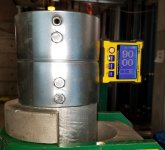krus
Member
- Location
- Springfield MO
- Occupation
- Electrical Engineer
I am designing a project with a good amount of conduit. I will need a couple 2" conduit runs coming out of my panel. I would like to be able to come out of the bottom of the panel into an LB then bend the 2" to 90degrees and run up the backside of the panel. My main concern with this is that the bend would have to be fairly close to the threads needed for the LB. I have no problem keeping the minimum bend radius found in the NEC (about 9.5") but is there a standard or a general industry rule of thumb for how far away from the bend I should keep my threads or am I just limited by my bending and threading equipment? I would like to be able to have a standard for all sizes of conduits for any future design work I do.

